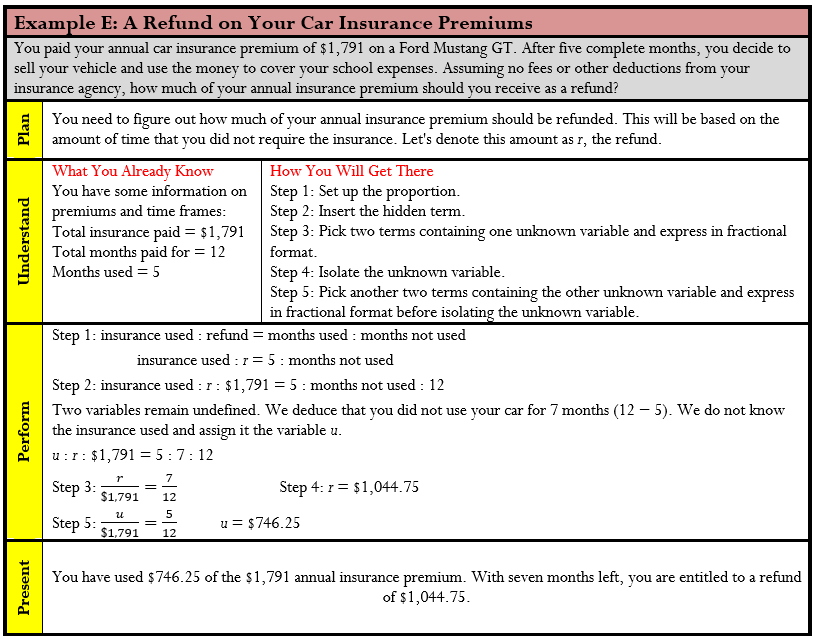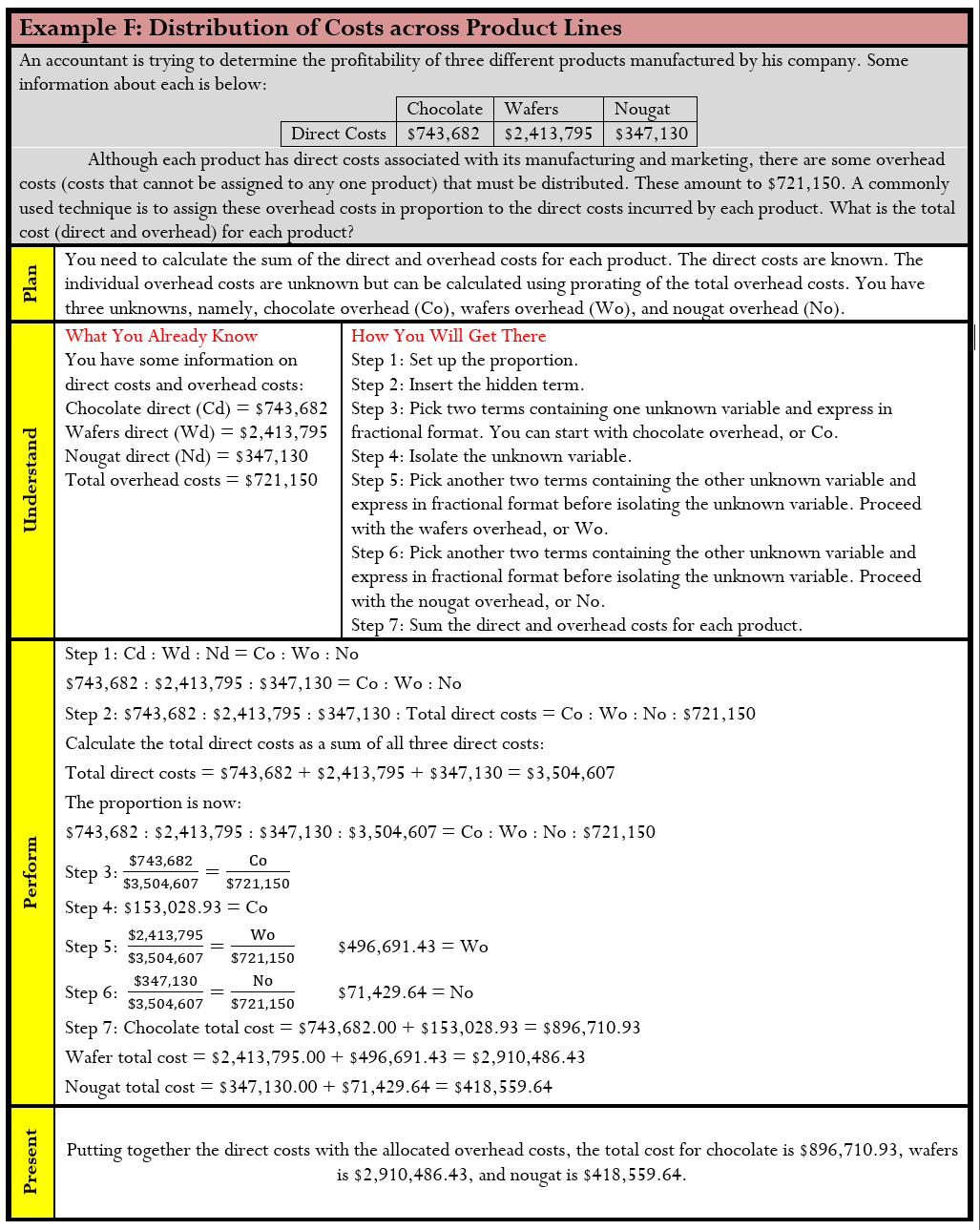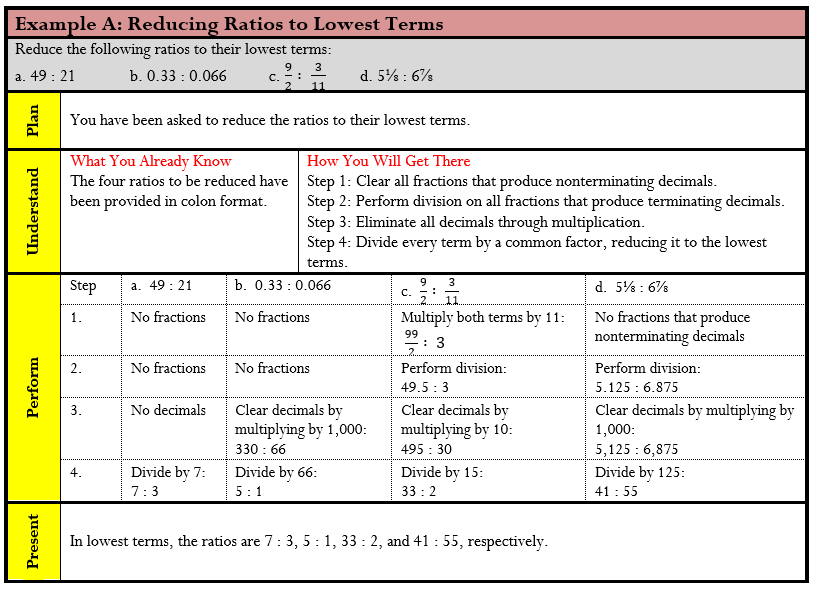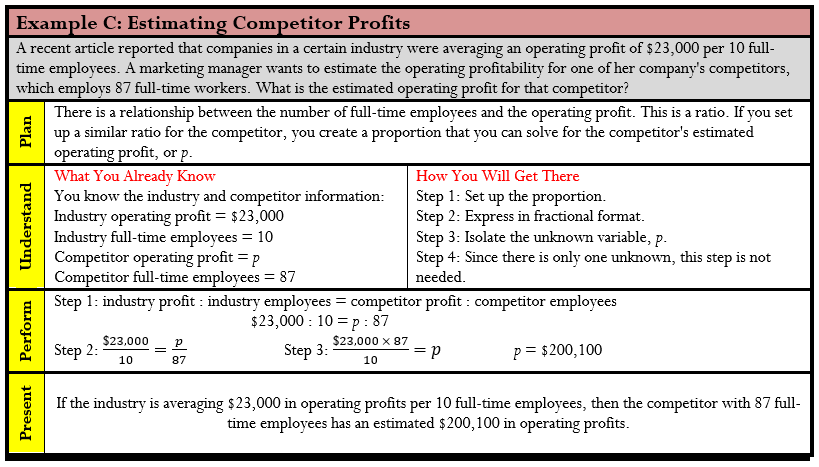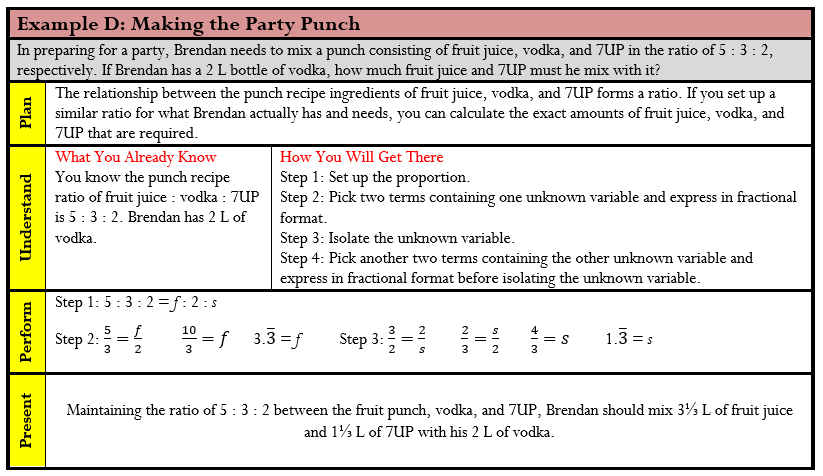12 Lesson 2
Izabela Mazur and Kim Moshenko
Ratios, Proportions, and Prorating
You and your business partner have a good problem: Consumers are snapping up packets of your new eucalyptus loganberry facial scrub as fast as you can produce them. Each packet of the scrub contains 600 mg of loganberry extract and 80 mg of eucalyptus oil, as well as water and clay and other ingredients. Ratios are invaluable in understanding the relationship among different quantities, such as how much of each ingredient you need.
You have no trouble obtaining the water and clay, but the loganberry extract and eucalyptus oil are in short supply because of poor weather. In any time period, your suppliers can provide seven times as much loganberry extract as eucalyptus oil. To figure out which ingredient is limiting your production, you need proportions.
Sometimes you need to relate a proportion to the total of the quantities. This requires prorating skills. For example, once your business has grown, you start using a production line, which follows the common practice of producing more than one product. The papaya facial scrub you have introduced recently and the eucalyptus loganberry scrub require the same amount of production time. Your equipment capacity is 1,000 units per day. How many units of each type of scrub must you produce to meet market demand in the ratio of nine to two?
Years later, you are splitting the profits of your business partnership in proportion to each partner’s total investment. You invested $73,000, while your partner invested $46,000. With total profits of $47,500, what is your share?
Understanding the relationships among various quantities and how the components relate to an overall total emphasizes the need for understanding ratios, proportions, and prorating.
What Is a Ratio?
A ratio is a fixed relationship between two or more quantities, amounts, or sizes of a similar nature. For a ratio to exist, all terms involved in the ratio must be nonzero. Examine the criteria of this definition more closely:
- There Must Be Two or More Quantities.
A ratio does not exist if only one quantity is involved. For example, the fuel tank on your Mustang takes 60 litres of gasoline. This is not a ratio, as there is no relationship to any other quantity, amount, or size. On the other hand, if you compare your fuel tank to the fuel tank of your friend’s Hummer, you now have two quantities involved and could say that her fuel tank has twice the capacity of yours. - All Terms Must Be of a Similar Nature.
In all of the examples provided note that all quantities, amounts, or sizes are based on the same unit. In the cosmetics formulation it was milligrams to milligrams; in the production line, it was units to units; in the investment scenario, it was dollars to dollars. For a ratio to have meaning and to be properly interpreted, all terms of the ratio must be expressed in a similar nature. When you place different units such as kilometres and metres into the same ratio, the result is confusing and will lead to misinterpretation of the relationship. - All Terms Must Be Nonzero.
The numbers that appear in a ratio are called the terms of the ratio. If we have a recipe with four cups of flour to one cup of sugar, there are two terms: four and one. If any term is zero, then the quantity, amount, or size does not exist. For example, if the recipe called for four cups of flour to zero cups of sugar, there is no sugar! Therefore, every term must have some value other than zero.
Let’s continue using the example of four cups of flour to one cup of sugar. Business ratios are expressed in five common formats, as illustrated in the table below.

All of these formats work well when there are only two terms in the ratio. If there are three or more terms, ratios are best expressed in the colon format. For example, if the recipe called for four parts of flour to one part of sugar to two parts of chocolate chips, the ratio is 4 : 1 : 2. The fraction, decimal, and percent forms do not work with three or more terms.
Simplification and Reduction of Ratios
When a ratio is used to express a relationship between different variables, it must be easy to understand and interpret. Sometimes when you set up a ratio initially, the terms are difficult to comprehend. For example, what if the recipe called for 62½ parts flour to 25 parts sugar? That is not very clear. Expressing the same ratio another way, you can say the recipe requires 5 parts flour to 2 parts sugar. Note how the relationship is clearer in the latter expression. Either way, though, both ratios mean the same thing; in decimal format this ratio is expressed as a value of 2.5. Recall that Section 2.2 discussed how fractions are expressed in higher and lower terms. We now apply the same knowledge to ratios to make the relationship as clear as possible.
When you reduce ratios to lower terms, remember two important characteristics involving the cardinal rule and integers:
- The Cardinal Rule.
The cardinal rule of algebra states, “What you do to one you must do to the other.” In other words, whatever mathematical operation is performed on a term in a ratio must be equally performed on every other term in the ratio. If this rule is violated then the relationship between the terms is broken. - Maintaining Integers.
Integers are easier to understand than decimals and fractions. In reducing a ratio to lower terms, aim to maintain every term as an integer.
How It Works
The steps involved in reducing ratios to lower terms are listed below. You may not need some steps, so skip them if the characteristic is not evident in the ratio.
Step 1: Clear any fractions that, when divided, produce a nonterminating decimal. Apply the rules of algebra and multiply each term by the denominator being cleared from the ratio. For example, if the ratio is , the first term when divided produces a nonterminating decimal. Clear the fraction by multiplying every term by the denominator of 3, resulting in a ratio of 1 : 6.
Step 2: Perform division on all fractions that produce a terminating decimal. For example, if the ratio is , both terms convert to terminating decimals, resulting in a ratio of 0.4 : 0.3.
Step 3: Eliminate all decimals from the ratio through multiplication. In other words, express the ratio in higher terms by multiplying every term by a power of 10. The power of 10 you choose must be large enough to eliminate all decimals. For example, if the ratio is 0.2 : 0.25 : 0.125, notice that the third term has the most decimal positions. A power of 1,000 (103) is required to move the decimal three positions to the right. Multiply every term by a power of 1,000, resulting in a ratio of 200 : 250 : 125.
Step 4: Find a common factor that divides evenly into every term, thus producing integers. If you find no such factors, then the ratio is in its lowest terms. For example, if the ratio is 10 : 4 : 6 it can be factored by dividing every term by 2, resulting in a ratio of 5 : 2 : 3. There is no common factor that reduces this ratio further; therefore, it is in its lowest terms.
Important Notes
To factor any term, recall your multiplication tables. Assume the ratio is 36 : 24. It is always best to pick the lowest term in the ratio when factoring. Looking at the 24 and recall what multiplies together to arrive at 24. In this case, your factors are 1 × 24, 2 × 12, 3 × 8, and 4 × 6. The goal is to find the largest value among these factors that also divides evenly into the other term of 36. The largest factor that makes this true is 12. Therefore, perform step 4 in our reduction process by dividing every term by a factor of 12, resulting in a ratio of 3 : 2.
Things To Watch Out For
Always ensure that before you apply any of the reduction steps your relationship meets the requirements of being a ratio in the first place. For example, the expression of 10 km : 500 m is not a 1 : 50 ratio since it violates the “similar nature” characteristic of the ratio definition. You need to convert the metres into kilometres, producing 10 km : 0.5 km. Now that you have a ratio, the reduction to lowest terms results in a 20 : 1 ratio. This is very different than 1 : 50! The lesson learned is to make sure you are working with a proper ratio before you manipulate it.
Paths To Success
In the fourth step of the procedure, do not feel compelled to find what is called the “magic factor.” This is the single factor that reduces the ratio to its lowest terms in a single calculation. Although this is nice if it happens, you may as well find any factor that will make the ratio smaller and easier to work with.
- For example, assume a ratio of 144 : 72 : 96. It may not be very apparent what factor goes into each of these terms on first glance. However, they are all even numbers, meaning they can all be divided by 2. This produces 72 : 36 : 48.
- Once again, the “magic factor” may not be clear, but every term is still even. Divide by 2 again, producing 36 : 18 : 24.
- If no magic factor is apparent, again note that all numbers are even. Divide by 2 yet again, producing 18 : 9 : 12.
- The common factor for these terms is 3. Divided into every term you have 6 : 3 : 4. There is no common factor for these terms, and the ratio is now in its lowest terms.
In the above example it took four steps to arrive at the answer—and that is all right. Did you notice the “magic factor” that could have solved this in one step? You can find it if you multiply all of the factors you have: 2 × 2 × 2 × 3 = 24. Dividing every term in the original ratio by 24 produces the solution in one step. If you did not notice this “magic factor,” there is nothing wrong with taking four steps (or more!) to get the answer. In the end, both methods produce the same solution.
Reducing a Ratio to the Smallest Term of One
Your goal in reducing a ratio is to make it easier to understand. Sometimes, even after you have applied the techniques for reducing the ratio, the end result is still hard to grasp. Look at part (d) of Example A. You arrived at a final solution of 41 : 55, with no further reduction possible. Think of this as 41 cups of flour to 55 cups of sugar. The relationship is not very clear.
In these circumstances, although integers are preferable in general, you must reduce the ratio further, reintroducing decimals to make the relationship more comprehensible. This means you apply a technique called “reducing the ratio to the smallest term of one.” In this technique, the smallest term in the ratio will have a value of 1 once you perform the ratio reduction and simplification.
How It Works
Follow these steps to reduce a ratio to the smallest term of one:
Step 1: Locate the smallest term in the ratio. (Do not just pick the first term.)
Step 2: Divide every term in the ratio by the selected smallest term. Every other term becomes a decimal number, for which either a clear rounding instruction is provided or you must obey the rounding rules used in this textbook. The smallest term by nature of the division equals one.
Let’s continue with part (d) of Example A, in which the reduced ratio is 41 : 55.
Step 1: Locate the smallest term in the ratio. It is the first term and has a value of 41.
Step 2: Take every term and divide it by 41 to arrive at . The decimal number allows you to roughly interpret the ratio as “one cup of flour to a touch over 1⅓ cups of sugar.” Although not perfect, this is more understandable than 41 : 55.
Important Notes
You may have to make a judgment call when you decide whether to leave a reduced ratio alone or to reduce it to a ratio where the smallest term is one. There is no clear definitive rule; however, keep the following two thoughts in mind:
- For purposes of this textbook, you are provided with clear instructions on how to handle the ratio, allowing everyone to arrive at the same solution. Your instructions will read either “Reduce the ratio to its smallest terms” or “Reduce the ratio to the smallest term of one.”
- In the real world, no such instructions exist. Therefore you should always base your decision on which format is easier for your audience to understand. If the reduced fraction leaves your audience unable to understand the relationship, then use the reduction to a ratio with the smallest term of one instead.
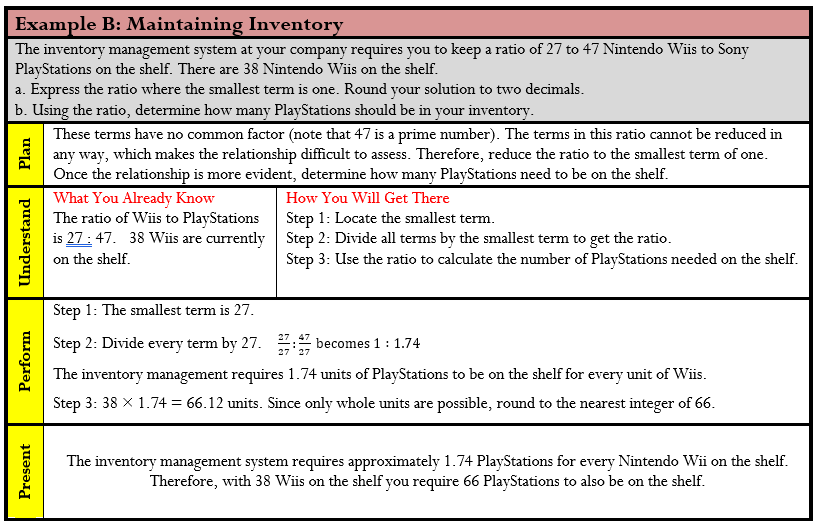
What Are Proportions?
Knowing the relationship between specific quantities is helpful, but what if your quantity happens not to match the specific quantity expressed in the existing ratio? Example B illustrated that you need to learn how to apply the ratio to meet current conditions. The ratio in the inventory system was expressed in terms of 27 Nintendo Wiis; however, the shelf displayed 38 units. How can we relate an existing ratio to a needed ratio?
A proportion is a statement of equality between two ratios. Just as we have both algebraic expressions and algebraic equations, there are ratios and proportions. With algebraic expressions, only simplification was possible. When the expression was incorporated into an algebraic equation, you solved for an unknown. The same is true for ratios and proportions. With ratios, only simplification is possible. Proportions allow you to solve for any unknown variable. The Wii and PlayStation example could have been set up as follows:
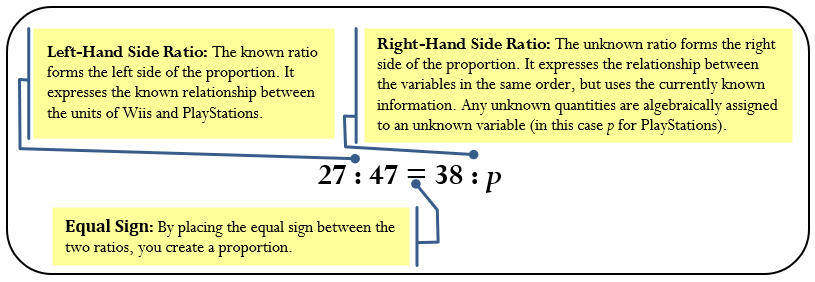
A proportion must adhere to three characteristics, including ratio criteria, order of terms, and number of terms.
- Characteristic #1: Ratio Criteria Must Be Met.
By definition, a proportion is the equality between two ratios. If either the left side or the right side of the proportion fails to meet the criteria for being a ratio, then a proportion cannot exist. - Characteristic #2: Same Order of Terms.
The order of the terms on the left side of the proportion must be in the exact same order of terms on the right side of the proportion. For example, if your ratio is the number of MP3s to CDs to DVDs, then your proportion is set up as follows:
MP3 : CD : DVD = MP3 : CD : DVD
- Characteristic #3: Same Number of Terms. The ratios on each side must have the same number of terms such that every term on the left side has a corresponding term on the right side. A proportion of MP3 : CD : DVD = MP3 : CD is not valid since the DVD term on the left side does not have a corresponding term on the right side.
When you work with proportions, the mathematical goal is to solve for an unknown quantity or quantities. In order to solve any proportion, always obey the following four rules:
- Rule #1:
At Least One Value for Any Term Is Known. At least one of the left side or right side values for each term must be known. For example, x : 5 = y : 10 is not a solvable proportion since the corresponding first terms on both sides are unknown. However, 15 : 5 = y : 10 is solvable since at least one of the first corresponding terms (the 15 and the y) is known. - Rule #2:
One Pair of Corresponding Terms Must Be Known. At least one pair of corresponding terms on the left side and right side must have both quantities known. For example, 3 : x : 6 = y : 4 : z is not a solvable proportion since there is no pair of first terms (3 and y), second terms (x and 4), or third terms (6 and z) that produces a pair of known values. However, 3 : x : 6 = 9 : 4 : z is a solvable proportion since the first terms on both sides (the 3 and 9) are known. - Rule #3:
Obey BEDMAS and Perform Proper Algebraic Manipulation. To manipulate a proportion, you must satisfy the rules of BEDMAS and all of the rules of algebra. Violating any of these rules breaks the equality of the ratios and produces an incorrect proportion. - Rule #4:
Use the Fractional Format. The fractional format for ratios is recommended for solving a proportion. The other four formats generally make solving the proportion much more difficult, and the mathematical operations required become unclear.
How It Works
Follow these steps in solving any proportion for an unknown variable or variables:
Step 1: Set up the proportion with the known ratio on the left side. Place the ratio with any unknown variables on the right side.
Step 2: Work with only two terms at a time, and express the two terms in fractional format. This is not a problem if the proportion has only two terms on each side of the equation, for example, 27 : 47 = 38 : p. This is expressed as If the proportion has three or more terms on each side, you can pick any two terms from each side of the proportion so long as you pick the same two terms on each side. In making your selection, aim to have a pair of terms on one side of the equation where both values are known while the other side of the equation is made up of one known term and one unknown term. For example, assume the proportion 6 : 5 : 4 = 18 : 15 : y. The selection of the first and third terms only on each side of the equation produces 6 : 4 = 18 : y. Notice that this is now a proportion with only two terms on each side, which you can express as
Step 3: Solve for the unknown variable. Obey the rules of BEDMAS and perform proper algebraic manipulation.
Step 4: If the proportion contained more than one unknown variable, go back to step 2 and select another pairing that isolates one of the unknown variables. Although one of the unknown variables is now known as a result of step 3, do not use this known value in making your selection. The danger in using a solved unknown variable is that if an error has occurred, the error will cascade through all other calculations. For example, assume the original proportion was 3 : 7 : 6 : 8 = x : y : z : 28. From step 2 you may have selected the pairing of 3 : 8 = x : 28, and in step 3 you may have erroneously calculated x = 11.5 (the correct answer is x = 10.5). In returning to step 2 to solve for another unknown variable, do not involve x in your next pairing. To isolate y, use 7 : 8 = y : 28 and not 3 : 7 = 11.5 : y, which will at least ensure that your calculation of y is not automatically wrong based on your previous error.
Things To Watch Out For
You must always pick terms from the same positions on both sides of the proportion. Otherwise, you will violate the equality of the proportion, since the terms are no longer in the same order on both sides and Characteristic #2 is not satisfied. For example, in working with the proportion 6 : 5 : 4 = 18 : 15 : y from above, you cannot select the first and third terms on the left side and also select the second and third terms on the right side. In other words, 6 : 4 ≠ 15 : y since 1st term : 3rd term ≠ 2nd term : 3rd term.
Paths To Success
It is always easiest to solve a proportion when the unknown variable is in the numerator. This characteristic requires minimal algebra and calculations to isolate the variable. If you find yourself with an unknown variable in the denominator, you can mathematically invert the fraction on both sides, since this obeys the cardinal rule of “what you do to one, you must do to the other.” When you invert, the numerator becomes the denominator and vice versa. For example, if the proportion is
inversion then produces a proportion of
Notice that isolating the unknown variable in the inverted proportion requires only a multiplication of 12 on both sides. This is a lot less work!
Give It Some Thought
- Some of the following proportions violate the characteristics or rules of proportions. Examine each and determine if all the rules and characteristics are met. If not, identify the problem.
| a. 4 : 7 = 6 : y | b. 5 : 3 = 6 : a : b | c. 6 km : 3 m = 2 m : 4 km | d. 6 : k = 18 : 12 |
| e. 4 : 0 = 8 : z | f. 9 = p | g. 4 : 7 : 10 = d : e : f | h. y : 10 : 15 = x : 30 : z |
- In the following solved proportions, which person properly executed step 2 of the proportion steps?
| 6 : 5 : 4 : 3 = x : y : z : 9 | ||
| Person A: 6 : 5 = x : y | Person B: 4 : 3 = y : 9 | Person C: 4 : 3 = z : 9 |
Click to Reveal Solutions:
- OK
- Not the same number of terms on each side (Characteristic #3)
- Terms are not in same units; terms are not in the same order (Characteristics #1 and #2)
- OK
- Does not meet ratio criteria; there is a term of zero (Characteristic #1)
- Does not meet ratio criteria; must have at least two terms on each side (Characteristic #1)
- There is no corresponding known term on both sides; every pair of terms contains an unknown (Rule #2)
- The first corresponding term is not known on both sides; at least one needs to be known (Rule #1)
- Person C did it right. Person A failed to isolate a variable, and different terms were extracted by Person B (3rd term : 4th term ≠ 2nd term : 4th term).
What Is Prorating?
Ratios and proportions are commonly used in various business applications. But there will be numerous situations where your business must allocate limited funds across various divisions, departments, budgets, individuals, and so on. In the opener to this section, one example discussed the splitting of profits with your business partner, where you must distribute profits in proportion to each partner’s total investment. You invested $73,000 while your partner invested $46,000. How much of the total profits of $47,500 should you receive?
The process of prorating is the taking of a total quantity and allocating or distributing it proportionally. In the above example, you must take the total profits of $47,500 and distribute it proportionally with your business partner based on the investment of each partner. The proportion is:
your investment : your partner’s investment = your profit share : your partner’s profit share
This proportion has two major concerns:
- You don’t know either of the terms on the right side. As per the rules of proportions, this makes the proportion unsolvable.
- There is a piece of information from the situation that you didn’t use at all! What happened to the total profits of $47,500?
Every prorating situation involves a hidden term. This hidden term is usually the sum of all the other terms on the same side of the proportion and represents a total. In our case, it is the $47,500 of total profits. This quantity must be placed as an extra term on both sides of the proportion to create a proportion that can actually be solved.
How It Works
Prorating represents a complex proportion. As such, the steps involved in prorating are similar to the steps for solving any proportion:
Step 1: Set up the proportion with the known ratio on the left side. Place the ratio with any unknown variables on the right side.
Step 2: Insert the hidden term on both sides of the proportion. Usually this term represents the total of all other terms on the same side of the proportion.
Step 3: Working with only two terms at a time, express the two terms in fractional format. Ensure that only one unknown variable appears in the resulting proportion.
Step 4: Solve for the unknown variable. Ensure that the rules of BEDMAS are obeyed and proper algebraic manipulation is performed.
Step 5: If the prorating contains more than one unknown variable, go back to step 3 and select a pairing that isolates another one of the unknown variables.
To solve your profit-splitting scenario, let y represent your profit share and p represent your partner’s share:
Step 1: your investment : your partner’s investment = your profit share : your partner’s profit share
$73,000 : $46,000 = y : p
Step 2: Insert the hidden total term on both sides:
| your investment | : | your partner’s investment | : | total investment | = | your profit share | : | your partner’s profit share | : | total profits |
$73,000 : $46,000 : $119,000 = y : p : $47,500
Step 3: Set up one proportion:
Step 4: Solve for y. Calculate y = $29,138.66.
Step 5: Set up the other proportion:
Solve for p. Calculate p = $18,361.34.
Your final proportion is:
$73,000 : $46,000 : $119,000 = $29,138.66 : $18,361.34 : $47,500.00
So you will receive $29,138.66 of the total profits and your partner will receive $18,361.34.
Important Notes
To make prorating situations easier to solve, it is always best to insert the hidden term as the last term on both sides of the equation. This forces the unknown variables into the numerator when you select pairs of terms. It then takes less algebra for you to isolate and solve for the unknown variable.
Things To Watch Out For
Ensure that when you insert the hidden term you put it in the same position on both sides of the proportion. A common error is to put the total on the “outsides” of the proportion:
A : B = C : D when prorated becomes
Total : A : B = C : D : Total
This violates the proportion characteristics, since the terms are not in the same order on both sides. The correct insertion of the hidden total term makes the proportion look like this:
A : B : Total = C : D : Total
Paths To Success
Another way of approaching prorating is to calculate a “per unit” basis and then multiply each term in the proportion by this base. For example, assume you are distributing $100 across three people, who have shares of three, five, and two. This is a total of 10 shares (the hidden term). Therefore, $100 divided by 10 shares is $10 per share. If the first person has three shares, then $10 × 3 = $30. The second and third people get $10 × 5 = $50 and $10 × 2 = $20, respectively. Therefore,
3 : 5 : 2 : 10 = $30 : $50 : $20 : $100
